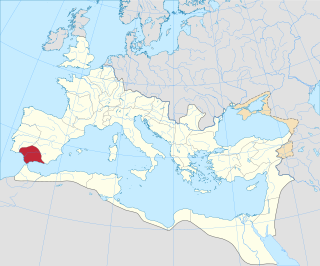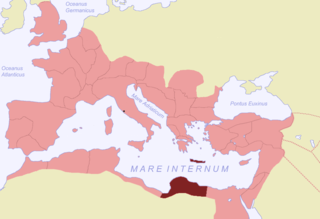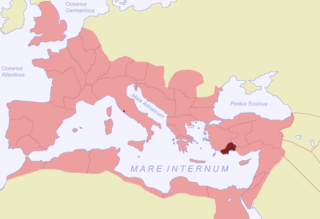Related Research Articles

Gallia Lugdunensis was a province of the Roman Empire in what is now the modern country of France, part of the Celtic territory of Gaul formerly known as Celtica. It is named after its capital Lugdunum, possibly Roman Europe's major city west of Italy, and a major imperial mint. Outside Lugdunum was the Sanctuary of the Three Gauls, where representatives met to celebrate the cult of Rome and Augustus.

The gens Petronia was a plebeian family at ancient Rome. This gens claimed an ancient lineage, as a Petronius Sabinus is mentioned in the time of Lucius Tarquinius Superbus, the last of the Roman kings, but few Petronii are mentioned in the time of the Republic. They are frequently encountered under the Empire, holding numerous consulships, and eventually obtaining the Empire itself during the brief reign of Petronius Maximus in AD 455.

Legio XXII Primigenia was a legion of the Imperial Roman army dedicated to the goddess Fortuna Primigenia. Founded in AD 39 by the emperor Caligula for use in his campaigns in Germania, the XXII Primigenia spent much of their time in Mogontiacum up to the end of the 3rd century. The legion's symbols were a Capricorn and the demigod Hercules.

Africa Proconsularis was a Roman province on the northern African coast that was established in 146 BC following the defeat of Carthage in the Third Punic War. It roughly comprised the territory of present-day Tunisia, the northeast of Algeria, and the coast of western Libya along the Gulf of Sirte. The territory was originally inhabited by Berber people, known in Latin as Mauri indigenous to all of North Africa west of Egypt; in the 9th century BC, Phoenicians built settlements along the Mediterranean Sea to facilitate shipping, of which Carthage rose to dominance in the 8th century BC until its conquest by the Roman Republic.

Hispania Baetica, often abbreviated Baetica, was one of three Roman provinces in Hispania. Baetica was bordered to the west by Lusitania, and to the northeast by Hispania Tarraconensis. Baetica remained one of the basic divisions of Hispania under the Visigoths down to 711. Baetica was part of Al-Andalus under the Moors in the 8th century and approximately corresponds to modern Andalusia.

Pannonia Inferior, lit. Lower Pannonia, was a province of the Roman Empire. Its capital was Sirmium. It was one of the border provinces on the Danube. It was formed in the year 103 AD by Emperor Trajan who divided the former province of Pannonia into two parts: Pannonia Superior and Pannonia Inferior. The province included parts of present-day states of Hungary, Serbia, Croatia, and Bosnia and Herzegovina. The province was bordered to the east by a Sarmatian tribe—the Iazyges. Later, the Vandals appeared to the north-east.

Crete and Cyrenaica was a senatorial province of the Roman Empire, established in 67 BC. It comprised the island of Crete and the region of Cyrenaica in present-day Libya.

Lycia et Pamphylia was the name of a province of the Roman empire, located in southern Anatolia. It was created by the emperor Vespasian, who merged Lycia and Pamphylia into a single administrative unit. In 43 AD, the emperor Claudius had annexed Lycia. Pamphylia had been a part of the province of Galatia.
Publius Martius Verus was a Roman senator and general. He was twice consul. Verus played a major role in the suppression of the revolt of Avidius Cassius by remaining loyal to the emperor Marcus Aurelius.
The gens Roscia, probably the same as Ruscia, was a plebeian family at ancient Rome. Members of this gens are mentioned as early as the fifth century BC, but after this time they vanish into obscurity until the final century of the Republic. A number of Roscii rose to prominence in imperial times, with some attaining the consulship from the first to the third centuries.
The gens Sallustia, occasionally written Salustia, was a plebeian family at ancient Rome. Members of this gens are first mentioned in the time of Cicero, and from that time they attained particular distinction as statesmen and writers. The most illustrious of the family was the historian Gaius Sallustius Crispus, who wrote valuable works on the Jugurthine War and the Conspiracy of Catiline, which still exist.
References
- ↑ Géza Alföldy, Konsulat und Senatorenstand unter der Antoninen (Bonn: Rudolf Habelt Verlag, 1977), p. 253 dates c. 135-c. 138
- ↑ Date from Werner Eck, "Jahres- und Provinzialfasten der senatorischen Statthalter von 69/70 bis 138/139", Chiron, 13 (1983), p. 192
- ↑ Alföldy, Konsulat und Senatorenstand, p. 254 dates c. 144-c. 147
- ↑ Alföldy, Konsulat und Senatorenstand, p. 254
- ↑ Alföldy, Konsulat und Senatorenstand, p. 254 dates c. 157
- 1 2 3 Paul M. M. Leunissen, Konsuln und Konsulare in der Zeit von Commodus bis Severus Alexander (180-235 n. Chr.) (Amsterdam, 1989), p. 285
- ↑ Leunissen, Konsuln und Konsulare, p. 285 dates between 198 & 209
- ↑ Leunissen, Konsuln und Konsulare, p. 285 dates c. 212
- ↑ Leunissen, Konsuln und Konsulare, p. 235
